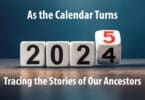Are you stuck in your genealogy research? You are probably looking for clues as to the parentage of a particular ancestor and have hit the infamous genealogy brick wall. Or, you could be trying to figure out how someone in your family tree is related to someone else. You know they must be related… all of the clues are there. You just don’t have the exact evidence you need to prove they are related, or how they are related. It can be frustrating, especially when you believe you have exhausted all possible clues and gone through every conceivable record source. Don’t give up, though! There are still clues to be found in the most obvious, and yet overlooked, of places. Take a look at your ancestors’ first names.
Why Are First Names Important in Genealogy?
When you are doing your genealogy, you probably concentrate a lot on last names. This is good to a certain extent. Last names connect generations on the male side. They can help you when researching your father’s side of the family, or any other branch of the family where a particular last name is your target. However, they can only take you so far. When the records run out (at least the obvious and available ones), you may be left wondering how certain people of the same last name are related… or IF they are related at all (especially if the last name is a common one).
First names can help you figure out the relationships between people in your family tree. Whether it is trying to decide if someone with the same last name as your ancestor is related (or how they are related), or attempting to determine the unknown maiden name of a female ancestor, first names can offer all kinds of amazing clues to follow.
First Names Connect Families
First names can connect families just as much as last names can… sometimes more. They are often passed down through generation after generation. Other times, they are used to ensure a mother’s maiden name lives on in some way. It isn’t unusual for a person to be given the mother’s maiden name as a first name (or as a middle name… don’t forget to look at middle names, too).
Here is a way first names can be useful, taken from my own genealogy research. A client had hit a brick wall with a particular branch of their family. They had the family traced back to their great-great-great-great grandfather but did not know his wife’s name or maiden name. The courthouse in the count in which the lived burned long ago, taking all potentially useful records with it, and the census records in which the family appeared were all pre-1850, so only the head of household was listed.
First names offered a clue as to the missing wife’s origins. The great-great-great-great grandfather had a son named Mathew Albritton Johnson. The first name was spelled with only one “t” in “Mathew,” instead of the normal two “t’s.” The middle name “Albritton” was also a clue. Mathew Albritton Johnson had a son of his own, also called Mathew (with just one “t”). A brother of Mathew Albritton Johnson had a son named George Albritton Johnson, and a grandson named Nathaniel Mathew Johnson. So Mathew’s brother used both Albritton and the one “t” Mathew in his own family. Therefore, the names Mathew (with one “t”) and Albritton are both clues.
I immediately suspected that the missing wife’s maiden name may have been Albritton since that is a surname that appeared on several early census records in the area where this family originated. Its use within the Johnson family as a middle name indicated it had some meaning to them. The name Mathew (with one “t”) also indicated meaning within this particular branch of the Johnson family.
Looking at census records for the generation of the missing wife’s parents, there was a Mathew Albritton living in the area and could have easily been her father. However, this was not enough to provide concrete proof. A look at the records of the state archives showed some old land maps that did not go down with the burned courthouse since they were kept by the state. These maps showed Mathew Albritton living next door to the Johnson family I was researching.
They were neighbors at the time when their children would have been growing up and getting to know each other. It was normal to marry neighbors in rural areas such as where this family lived. Mathew Albritton living right next door was the closest proof I could get (so far) to showing the missing wife’s maiden name was Albritton and that Mathew Albritton was her father. Additional research into Mathew Albritton may reveal his children’s names and who they married. DNA tests with members of the Albritton family may also show a genetic connection.
This is just one example of how first names can be used to identify ancestors. The continued use of the unusually spelled Mathew and the name Albritton in this family provided clues to a missing great-great-great-great grandmother’s maiden name and heritage. When you are looking for relationships within families, look at the use of first names and middle names across the generations. Consider where those names originated. Search for their origins if you have to. Then, use the origin of the names, as well as how they were used in subsequent generations of the family (even sometimes to the present day, where their origins have temporarily been lost until you start researching them) to give you the clues you need to put family relationships that have been lost to history back together.






